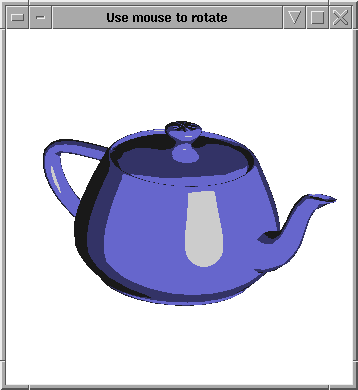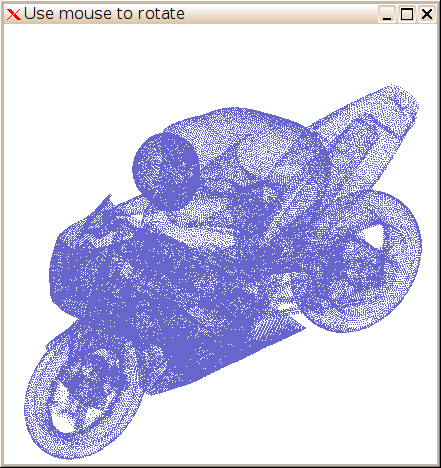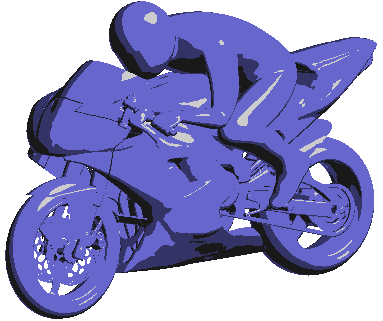| Version 52 (modified by , 12 years ago) (diff) |
|---|
Visualization with OpenGL
Essential approaches to programming computer graphics with Open Graphics Language (OpenGL) graphics library are described. This document serves as the basis for exercises in PRACE Summer of HPC Visualization training. Rationale for giving introduction to OpenGL is that such knowledge is important when developing codes that require some specific visualization for which OpenGL can be handy. Programming Graphical Processing Unit (GPU) through shaders is an important technique to accelerate graphics and other embarrassing parallel problems. OpenGL evolved from immediate mode to GPU only processing with the advent of OpenGL Shading Language (GLSL). GLSL is used for tutorial without the tendency to introduce photo-realismas output but rather useful colors for scientific data exploration. Introduction to the subject is given by recipes to follow, discussing important techniques for visualization that can also be extended to general GPU programming for parallel computing. Instead of jumping to the latest OpenGL specification we use minimum required OpenGL 2.1 with the extensions currently available on modest hardware and still be able to use modern OpenGL 3.1+ programming principles.
Running this tutorial on Linux desktop one requires at least the OpenGL 2.1 graphics with the GLSL 1.2 and supporting libraries GL, GLU, GLUT, GLEW. This can be verified with the following commands:
$ glxinfo |grep OpenGL.*version OpenGL version string: 2.1 Mesa 8.0.5 OpenGL shading language version string: 1.20 $ ls /usr/include/GL/{glut.h,glew.h,gl.h,glu.h} /usr/include/GL/glew.h /usr/include/GL/glu.h /usr/include/GL/gl.h /usr/include/GL/glut.h
Introduction
For the visualization of specific phenomena is usually not possible to use a general purpose visualization tools. Such cases occur especially in the visualization of engineering and physics problems. The modeling results are usually not only simple function plots but complex objects such as graphs, hierarchical structure, animation, motion mechanism, control channels, volume models of specific forms, ...
Through the time different standards were effective for computer graphics. This is mainly due to the complexity of implementation and closed code in the past. OpenGL remains the only widely accepted open standard, which was first introduced on Silicon Graphics workstations (SGI). There exist also a Microsoft Direct3D, which is limited to PCs with Windows and is not as easy to use as OpenGL, which is due to its openness and capacity provided on all operating systems and hardware platforms. OpenGL stagnated for some time with upgrades to the original SGI specification. Many extensions previously available from hardware vendors are now standardized with OpenGL 3+ where things dramatically changed. Immediate mode programming where communication from OS to GPU was regular practice and major obstacle to graphics performance. Programming knowledge of OpenGL 1.x is therefore not recommended for nowadays and can simply be forgotten and treated as legacy.
Modern OpenGL changed previously fixed rendering pipeline to fully
programmable graphics pipeline as shown in Fig.1
Processors that transform input vertex data to the window context at the
end are called shaders. The Vertex shader and the Fragment shader
are most important in the rendering pipeline. To use rendering pipeline as
shown in Fig.1 one has to provide program for them
as there is no default because they are essential part of every OpenGL
program. Programming shaders is done in GLSL (OpenGL Shading Language) that
is similar to C language with some predefined variables and reserved
keywords that help describing communication between OS and GPU. Programs
(for shaders) written in GLSL are compiled on-the-fly, assembled and
transferred to GPU for execution.
OpenGL is designed as a hardware-independent interface between the program code and graphics accelerator. Hardware independence of OpenGL means also that in the language specification there is no support for control of window system events that occur with interactive programming. For such interactive control for each operating system were designed interfaces that connect the machine with the OpenGL system. Due to the specifics of different window systems (Windows, XWindow, MacOS, iOS, Android) it is required that for each system tailored techniques are used to call OpenGL commands in hardware. Portability is thus limited by graphical user interface (GUI) that handles OpenGL context (window). In order to still be able to write portable programs with otherwise limited functionality of the user interface, GLUT library (OpenGL Utility Toolkit) was created. It compensates all the differences between operating systems and introduces a unified methods of manipulating events. With the GLUT library it is possible to write portable programs that are easy to write and have sufficient capacity for simple user interfaces.
Legacy OpenGL
Basics of the OpenGL language are given in the (core) GL library. More complex primitives can be build by the GLU library (GL Utility) which contain the routines that use GL routines only. GLU routines contain multiple GL commands that are generally applicable and have therefore been implemented to ease OpenGL programming.
To get quickly introduced into OpenGL it is better to start with legacy (short and simple) program that will be later replaced with modern OpenGL after discussion that caused replacement with OpenGL 3.x. Unfortunately FORTRAN support for modern OpenGL is lacking bindings for GLEW. Legacy OpenGL programming in Fortran is still possible. Before we can dive in OpenGL we need to revise windowing systems and how they interact with users.
Events
All window interfaces (GUI) are designed to operate on the principle of events. Events are signals from the Window system to our program. Our program is fully responsible for the content of the window. Windowing system only assigns area (window). The contents of the window area must then be fully controlled. In addition to the window assignment the windowing system to sends messages (events) to our program. The most common messages are:
- display
- The command asks for presentation of window contents. There are several possible occasions when this happens. For example, when another window reveals part of our window or when window is moved on the screen. Another example is when window is re-displayed after icon is being pressed at the taskbar. Interception of such events is mandatory, because every program must ensure that the contents of the window is restored window, when such event occurs.
- reshape
- Command to our program that occurs when the size and/or shape of the window changes. In this case the content of the window must be provided for a new window size. Event occurs, inter alia, when the mouse resizes the window. Immediately after reshape, display event is sent.
- keyboard
- Commands coming from the keyboard.
- mouse
- Describes the mouse buttons at their change when user pressed or released one of the buttons.
- motion
- This command defines the motion tracking of the moving mouse with pressed button.
- timer
- Program requests message after a certain time in order to change the contents of the window. The function is suitable for timed simulation (animation).
GLUT
For an abstraction of events (commands from the windowing system) we will
use GLUT library (OpenGL Utility Toolkit). Many other GUI libraries are
available (native and portable). GLUT falls into the category of simple
operating/windowing system independent GUIs for OpenGL. An example of a
minimal program that draws a single line is shown in Listing 1 (first.c).
\lstinputlisting[caption=Drawing a line with OpenGL and GLUT.,
label=first.c ]{first.c} Program in C language consists of two parts: the
subroutine display and the main program. Program runs from the start in
main() and at the end falls into endless loop
glutMainLoop that calls registered subroutines when event
occurs. Before falling into glutMainLoop we need to prepare drawing
context.
Listing 1: #include <GL/glut.h> void display() { glClear(GL_COLOR_BUFFER_BIT); glColor3f(1.0, 0.4, 1.0); glBegin(GL_LINES); glVertex2f(0.1, 0.1); glVertex3f(0.8, 0.8, 1.0); glEnd(); glutSwapBuffers(); } int main(int argc, char *argv[]) { glutInit(&argc,argv); glutInitDisplayMode(GLUT_DOUBLE); glutCreateWindow("first.c GL code"); glutDisplayFunc(display); glutMainLoop(); return 0; } |
Listing 2: from OpenGL.GLUT import * from OpenGL.GL import * import sys def display(): glClear(GL_COLOR_BUFFER_BIT) glColor3f(1.0, 0.4, 1.0) glBegin(GL_LINES) glVertex2f(0.1, 0.1) glVertex3f(0.8, 0.8, 1.0) glEnd() glutSwapBuffers() if __name__ == "__main__": glutInit(sys.argv) glutInitDisplayMode(GLUT_DOUBLE) glutCreateWindow("first.py GL code") glutDisplayFunc(display) glutMainLoop()
|
Structure of the program is usually very similar for all languages. Confer Listing 2 (first.py) rewritten in Python. All GLUT programs include commands in the following order:
- Include definitions of constants and functions for OpenGL and GLUT with the include statement.
- Initialize GLUT and setup other variables that are not directly related to OpenGL but rather to the object that is being visualized.
- Set window parameters such as initial position, size, type, bit plane memory.
- Create the window and name it.
- Setup the features of the OpenGL machine. These are usually commands
glEnablefor setup of lighting, materials, lists, and non-default behavior of OpenGL machine. - Register call-back routines which will be called at events. Mandatory
registration is just for
glutDisplayFunc(display). The rest are optional. - The last command in
mainis a call toglutMainLoop, from which the program returns when the window is closed. At the same time themainprogram ends.
The command glutInit initializes GLUT library routines. It is followed by
a request for window creation of a certain type. The constant GLUT_DOUBLE
and the default GLUT_RGB suggests that we want a double-buffered window
with a RGB space. Variable window keeps reference of window returned by
glutCreateWindow and at the same time instructs the OS to set the window
title. We have to tell to the window system which events the program will
intercept. For example given, this is only display of the contents of the
window. Call of the subroutine glutDisplayFunc instructs the
glutMainLoop that whenever requests from OS for window redisplay occurs
subroutine display should be called. Routines for handling events are
usually called call-back routines as it reside in program as standalone
code snippets that are called auto-magically at certain events from the
windowing system. When some event occurs is up to the windowing system that
follows user interaction. The main point to emphasize here is that
registered call-back routines do get additional information on the kind of
event. For example of keyboard event we can get also mouse (x,y)
coordinates besides the key pressed.
We have seen that the subroutine display includes commands responsible
for drawing in the window. All routines or functions there are OpenGL and
have prefix gl to the name. Prefix is necessary to distinguish them and
prevent name clash with other libraries. To understand the language one can
interpret function names without prefixes and suffixes as the OpenGL is
designed so, that the types of the arguments for all programming languages
are similar. Subroutine display is therefore responsible for drawing the
contents of the window. The glClear command clears the entire area of the
window. When clearing we need to define precisely what we want to clear by
argument given. In our case, this is GL_COLOR_BUFFER_BIT, which means
clearing of all pixels in the color buffer.
The glColor command to sets the current color of graphic elements that
will be drawn in subsequent commands. As an argument RGB color components
are passed. Usually commands with multiple arguments are provide for
different data types (integer, float, double) and some command can have
different number of arguments for the same command. To distinguish them
suffix is added. For the glColor3f suffix 3f therefore means that the
subroutine has three arguments of type float. Choice of the arguments type
depends on application requirements. Programmer can freely choose data type
that suits most without the need of data type conversion. In our example we
have two variants for vertex command with different number of arguments of
the same type. glVertex2f means that we are specifying just two
coordinates while the third is by default z=0. Types of the arguments
specified as the suffix letter are as follows:
- f
- float in C language and
real*4in Fortran. - d
- double for C and
real*8in Fortran. - i
- integer (4 bytes).
- s
- short integer in C and
integer*2in Fortran.
v at the end. Below are some interpretations of suffixes:
- 3f
- Three arguments of
reals follow as arguments. - 3i
- Three arguments of
integers follow as arguments. - 3fv
- One argument as a vector that contains three
floats follows.
glVertex
command where we can find
glVertex2d, glVertex2f, glVertex2i, glVertex2s, glVertex3d, glVertex3f, glVertex3i, glVertex3s, glVertex4d, glVertex4f, glVertex4i, glVertex4s, glVertex2dv, glVertex2fv, glVertex2iv,glVertex2sv, glVertex3dv, glVertex3fv, glVertex3iv, glVertex3sv, glVertex4dv,glVertex4fv, glVertex4iv, glVertex4sv.
Large number of routines for the same function is performance and language
related in order to waive the default conversion and thus provide a more
comprehensive and faster code. For languages with name mangling like C++
one can find simpler OpenGL wrapped functions (eg. just glVertex) that
don't affects performance. But as many languages does not have name
mangling built into compiler such practise is not widespread. Besides
specifying single vertex each time one can use glVertexPointer and points
to memory where number of vertices of specified type exist. This can save
us of some looping, but as this is essentially copying of system memory
into OpenGL hardware engine, the performance is not really improved.
Drawing of graphic primitives in OpenGL occurs between two commands
glBegin(primitive type) and glEnd(). Primitive type given as argument
at the beginning specifies how subsequent vertices will be used for
primitive generation. Instead of giving primitive type as number several
predefined constant are provided within include directive to ease
readability and portability of the OpenGL programs. Before providing vertex
position one can change OpenGL engine primitive state such as current
drawing glColor3f or glNormal that is per vertex property.
The last command in the display subroutine is glutSwapBuffers(). For
applications in which the contents of the display changes frequently, it is
most appropriate to use windows dual graphics buffers, which is setup by
using the GLUT_DOUBLE at window initialization. The advantage of such
drawing strategy is in the fact that while one buffer is used for current
drawing the other is shown. Drawing thus occurs in the background and when
buffer is ready for display we simply flip the buffers. In particular it
should be noted that such behaviour is system dependent and once upon a
time when the GLUT_SINGLE (without double buffers) with the glFlush()
at the end was used instead. Nowadays GLUT_DOUBLE is usually used, which
is most helpful with high frame-rate applications such as animation.
Only simple primitives are used within OpenGL. Reason for that is mainly
due to the requirement of performance and possible hardware acceleration.
There are three types of simple primitives: points, lines, and triangles.
Higher level primitives (like quadrilaterals) can be assembled from simple
ones. Curves can be approximated by lines. Large surfaces can be tessellated
with triangles. For complex surfaces (like NURBS) GLU library can be used
to calculate vertices. The following line primitives are possible:
- GL_LINES
- Pairs of vertices in a vertex stream create line segments.
- GL_LINE_STRIP
- Vertex stream builds connected lines (polyline).
- GL_LINE_LOOP
- Same as polyline above except that last vertex is connected by a line to the first.
- GL_TRIANGLES
- For each triangle three vertices are required from vertex stream.
- GL_TRIANGLE_STRIP
- Strip of triangles. For first triangle three vertices are needed. For every additional vertex new triangle is created by using last two vertices.
- GL_TRIANGLE_FAN
- Triangles are added to the first one by using first and last vertex to create a triangle fan.
Exercises #1:
- Create the following
first.cusing your favorite editor.
#include <GL/glut.h> void display() { glClear(GL_COLOR_BUFFER_BIT); glColor3f(1.0, 0.4, 1.0); glBegin(GL_LINES); glVertex2f(0.1, 0.1); glVertex3f(0.8, 0.8, 1.0); glEnd(); glutSwapBuffers(); } int main(int argc, char *argv[]) { glutInit(&argc,argv); glutInitDisplayMode(GLUT_DOUBLE); glutCreateWindow("first.c GL code"); glutDisplayFunc(display); glutMainLoop(); return 0; }
Create the Makefile to build your program.
CFLAGS=-Wall -g LDFLAGS=-lGL -lGLU -lglut -lGLEW ALL=first default: $(ALL) first : first.o clean: rm -rf *.o *~ [!m]*.obj core* $(ALL)
Beware that Makefile is TAB aware. So the last line should contain TAB indentation and not spacing.
Make and run the program with
make ./first
- Add RGB color to vertices with
glColor3f(0.0, 0.4, 1.0);. - Replace single line drawing in
display()with the following snippetand try to draw two wireframe triangles in a loop. Change primitive toGLfloat vertices[][2] = { { -0.90, -0.90 }, // Triangle 1 { 0.85, -0.90 }, { -0.90, 0.85 }, { 0.90, -0.85 }, // Triangle 2 { 0.90, 0.90 }, { -0.85, 0.90 } };
GL_LINE_LOOP. - Draw two primitives with
GL_TRIANGLES.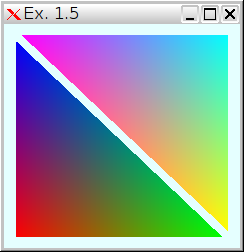
- Add different color to each vertex.
GLfloat color[][3] = { {1, 0, 0}, {0, 1, 0}, {0, 0, 1}, {1, 1, 0}, {0, 1, 1}, {1, 0, 1}};
- Replace loop with the following
How can we add color to vertices? See glColorPointer and glEnableClientState.
glVertexPointer(2, GL_FLOAT, 0, &vertices[0][0]); glEnableClientState(GL_VERTEX_ARRAY); glDrawArrays(GL_TRIANGLES, 0, 6); glDisableClientState(GL_VERTEX_ARRAY);
- Change background to
glClearColor(0.9,1,1,1.0);and suggest initial window inmain()glutInitWindowSize(512, 512); glutInitWindowPosition((glutGet(GLUT_SCREEN_WIDTH)-512)/2, (glutGet(GLUT_SCREEN_HEIGHT)-512)/2);
- Add keyboard event
to quit the program when pressing ESCape key with keycode 27 by adding callback function
and registering event within
void keyboard(unsigned char key, int x, int y) { if (key == 27) exit(0); }
main()byglutKeyboardFunc(keyboard);. Some preferkey == 'q', though.
Modern OpenGL
Immediate mode programming with glBegin and glEnd was removed from
OpenGL 3.x as such transmission of vertex streams and its attributes
(colors, normals, ...) from system memory to GPU is considered as a major
performance drawback. Display lists were previously used to save stream of
OpenGL calls that also included vertex data and was just replayed at
redraw. But this is inherently sequential operation that blocked parallel
vertex processing. Requirement to store vertex arrays to GPU directly as an
object can solve problem described. Storing vertex arrays into GPU
also means that manipulation on them to build the model should be inside
the GPU. Legacy OpenGL included many modelling utilities for
transforming world coordinates into viewport. Transformations of coordinate
systems in 3D space allowed manipulate model stack easily with
glPushMatrix and glPopMatrix commands. But similarly to
glBegin/glEnd such manipulations are not used outside GPU anymore.
Instead all operations on vertex data is transferred to vertex shader.
There operations on data can be performed with standard vector
math in homogeneous coordinates.
We extend previous exercise with example that introduces OpenGL 3.x techniques:
- OpenGL Shading Language (GLSL 1.2) where simple vertex and fragment shader are required.
- Vertex Aray Objects (VAOs) and vertex buffers (VBOs) stored in GPU.
Create triangle.c and update Makefile with new target
#include <stdio.h> #include <stdlib.h> #include <GL/glew.h> #include <GL/glut.h> GLuint program; GLuint vbo_vertices; GLint attribute_coord2d; static const GLchar * vertex_shader[] = { "attribute vec2 coord2d;" // input vertex position "void main()" "{" " gl_Position = gl_ModelViewProjectionMatrix*vec4(coord2d, 0.0, 1.0);" "}" }; static const GLchar * fragment_shader[] = {"void main()" "{" " gl_FragColor = vec4(0.4,0.4,0.8,1.0);" "}" }; void create_shaders() { GLuint v, f; v = glCreateShader(GL_VERTEX_SHADER); f = glCreateShader(GL_FRAGMENT_SHADER); glShaderSource(v, 1, vertex_shader, NULL); glShaderSource(f, 1, fragment_shader, NULL); glCompileShader(v); glCompileShader(f); program = glCreateProgram(); glAttachShader(program, f); glAttachShader(program, v); glLinkProgram(program); glUseProgram(program); attribute_coord2d = glGetAttribLocation(program, "coord2d"); if (attribute_coord2d == -1) { fprintf(stderr, "Could not bind attribute coord2d\n"); } glEnableVertexAttribArray(attribute_coord2d); } void send_buffers_to_GPU(void) { GLuint vertex_array_object; glGenVertexArrays(1, &vertex_array_object); glBindVertexArray(vertex_array_object); GLfloat vertices[][2] = { { -0.90, -0.90 }, // Triangle 1 { 0.85, -0.90 }, { -0.90, 0.85 }, { 0.90, -0.85 }, // Triangle 2 { 0.90, 0.90 }, { -0.85, 0.90 } }; glGenBuffers(1, &vbo_vertices); glBindBuffer( GL_ARRAY_BUFFER, vbo_vertices); glBufferData( GL_ARRAY_BUFFER, sizeof(vertices), vertices, GL_STATIC_DRAW); } void display(void) { glClear(GL_COLOR_BUFFER_BIT); glBindBuffer(GL_ARRAY_BUFFER, vbo_vertices); glVertexAttribPointer(attribute_coord2d, 2, GL_FLOAT, GL_FALSE, 0, NULL); glDrawArrays(GL_TRIANGLES, 0, 6); // Draw 6 vertices glutSwapBuffers(); } int main(int argc, char **argv) { glutInit(&argc, argv); glutInitDisplayMode(GLUT_RGBA | GLUT_DOUBLE); glutCreateWindow("GLSL Intro"); glutDisplayFunc(display); glewInit(); if (!glewIsSupported("GL_VERSION_2_0")) { printf("GLSL not supported\n"); exit(EXIT_FAILURE); } glClearColor(0.9,1.0,1.0,1.0); send_buffers_to_GPU(); create_shaders(); glutMainLoop(); return EXIT_SUCCESS; }
Exercises #2
- To be able to continue and not get lost introduce shader compiler logs in case of compilation errors by adding the following code into
create_shaders()right at after vertex shader compilation:Do not forget to repeat the same thing for fragment shader. Add linker debuggingGLint compiled; glGetShaderiv(v, GL_COMPILE_STATUS, &compiled ); if ( !compiled ) { GLsizei maxLength, length; glGetShaderiv( v, GL_INFO_LOG_LENGTH, &maxLength ); GLchar* log = malloc(sizeof(GLchar)*(maxLength+1)); glGetShaderInfoLog(v, maxLength, &length, log); printf("Vertex Shader compilation failed: %s\n", log); free(log); }
Create some error to verify if it works. For general (core) OpenGL errors we can use the followingGLint linked; glGetProgramiv(program, GL_LINK_STATUS, &linked ); if ( !linked ) { GLsizei len; glGetProgramiv(program, GL_INFO_LOG_LENGTH, &len ); GLchar* log = malloc(sizeof(GLchar)*(len+1)); glGetProgramInfoLog(program, len, &len, log ); printf("Shader linking failed: %s\n", log); free(log); }
glcheck()utility at suspicious places.#define glcheck() {GLenum s; if ((s=glGetError()) != GL_NO_ERROR) \ fprintf (stderr, "OpenGL Error: %s at line %d\n", \ gluErrorString(s), __LINE__);} 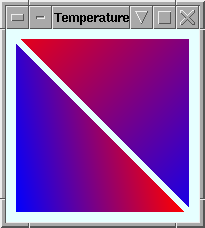 Copy
Copy triangle.cintotemperature.cand introduce vertex temperature with additional array and buffer at the end ofsend_buffers_to_GPU()and adding corresponding global attribute and VBOs IDs at the top ofGLfloat vertex_temperature[] = {0, 1, 0.2, 0.1, 0.5, 0.9}; glGenBuffers(1, &vbo_temperature); glBindBuffer(GL_ARRAY_BUFFER, vbo_temperature); glBufferData(GL_ARRAY_BUFFER, sizeof(vertex_temperature), vertex_temperature, GL_STATIC_DRAW);
temperature.cso that global section reads:Replace shaders withGLuint program; GLuint vbo_vertices; GLuint vbo_temperature; GLint attribute_coord2d; GLint attribute_temperature;
Bind temperature buffer and specify data layout withinstatic const GLchar * vertex_shader[] = { "" "attribute float temperature;" // custom variable along with vertex position "varying float t;" // communicate between the vertex and the fragment shader "void main()" "{" " t = temperature;" " gl_Position = gl_ModelViewProjectionMatrix * gl_Vertex;" "}" }; static const GLchar * fragment_shader[] = { "vec3 Cool = vec3(0, 0, 1);" // Red "vec3 Hot = vec3(1, 0, 0);" // Blue "varying float t;" // Interpolated by fragment "void main()" "{" " vec3 color = mix(Cool, Hot, t);" // use the built-in mix() function " gl_FragColor = vec4(color, 1.0);" // append alpha channel "}" };
display()just beforeglDrawElements()withWhat happens if we don't enable temperature vertex array? Confer temperature.c attached if having troubles.glBindBuffer(GL_ARRAY_BUFFER, vbo_temperature); glVertexAttribPointer(attribute_temperature, 1, GL_FLOAT, GL_FALSE, 0, NULL);
- Add additional custom vertex array for the pressure. Change the temperature array to have values in Celsius for water boiling range [0-100]°C. Pressure should be in the range of [0-1] MPa. Scaling to color range [0-1] should be done in shaders. Toggle between them with the keyboard event by using the keys
'p'and't' thatglEnableVertexAttribArray()andglDisableVertexAttribArray()corresponding vertex attribute arrays. 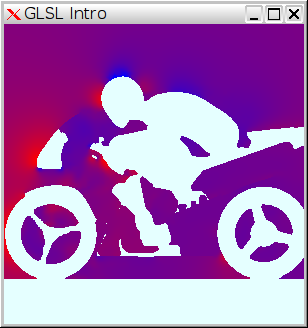 Fetch pressure data as 2D y-slice in file p_yNormal.vtk formatted in VTK that can be quickly read by the following code:
Insert this code into temperature.c and rename temperature with pressure everywhere. We will be drawing indexed so the last lines of the
Fetch pressure data as 2D y-slice in file p_yNormal.vtk formatted in VTK that can be quickly read by the following code:
Insert this code into temperature.c and rename temperature with pressure everywhere. We will be drawing indexed so the last lines of theGLfloat *point; int points; GLuint *triangle; int triangles; GLfloat *pressure; void read_VTK_pressure(const char *filename) { char line[80]; int i; FILE *f; f = fopen(filename, "r"); while(fgets(line, 80, f)) { if (strstr(line, "POINTS")) { float dummy_y; points = atof(line+7); point = malloc(points*2*sizeof(float)); pressure = malloc(points*sizeof(float)); assert(point != NULL && pressure != NULL); for(i = 0; i < points; ++i) fscanf(f, "%f %f %f", &point[i*2], &dummy_y, &point[i*2+1]); } else if (strstr(line, "POLYGONS")) { triangles = atof(line+9); triangle = malloc(triangles*3*sizeof(GLuint)); for (i = 0; i < triangles; ++i) { int n; fscanf(f, "%d %d %d %d", &n, &triangle[i*3], &triangle[i*3+1], &triangle[i*3+2]); } } else if (strstr(line, "FIELD")) { fgets(line, 80, f); // skip: p 1 27582 float for (i = 0; i < points; ++i) fscanf(f, "%f", &pressure[i]); } } fclose(f); printf("Read %d points for %d triangles for field %s\n", points, triangles, filename); }
display()now readsSending element data buffers to GPU is slightly changed by usingglBindBuffer(GL_ELEMENT_ARRAY_BUFFER, ibo_elements); glDrawElements(GL_TRIANGLES, triangles*3, GL_UNSIGNED_INT, 0); glutSwapBuffers();
GL_ELEMENT_ARRAY_BUFFERinstead ofGL_ARRAY_BUFFERin subroutinePositioning (translation) of the motorbike and scaling of the pressure [-300..200] to color mix range [0-1] can be done in shaders directly. Confer final pressure.c if having trubles with coding.void send_buffers_to_GPU(void) { GLuint vertex_array_object; glGenVertexArrays(1, &vertex_array_object); glBindVertexArray(vertex_array_object); glGenBuffers(1, &vbo_vertices); glBindBuffer(GL_ARRAY_BUFFER, vbo_vertices); glBufferData(GL_ARRAY_BUFFER, points*2*sizeof(GLfloat), point, GL_STATIC_DRAW); glGenBuffers(1, &vbo_pressure); glBindBuffer(GL_ARRAY_BUFFER, vbo_pressure); glBufferData(GL_ARRAY_BUFFER, points*sizeof(GLfloat), pressure, GL_STATIC_DRAW); glGenBuffers(1, &ibo_elements); glBindBuffer(GL_ELEMENT_ARRAY_BUFFER, ibo_elements); glBufferData(GL_ELEMENT_ARRAY_BUFFER, triangles*3*sizeof(GLuint), triangle, GL_STATIC_DRAW); }
Interactivity
Assemble the following Utah teapot model and attached virtual trackball.h and trackball.c sources from SGI. Teapot is built-in model for testing purposes in GLUT and uses legacy glBegin()/glEnd() commands and surface normals. Similarly deprecated GLSL usage of gl_Vertex and gl_Normal built-in input vertex attributes is used in vertex_shader[]. Nevertheless it is a good starting point for viewing applications.
#include <stdio.h> #include <stdlib.h> #include <string.h> #include <GL/glew.h> #include <GL/glut.h> #include "trackball.h" GLuint program; static const GLchar * vertex_shader[] ={"\ varying vec3 normal, lightDir;\ uniform mat4 RotationMatrix;\ void main()\ { \ lightDir=normalize(vec3(gl_LightSource[0].position));\ normal=normalize(gl_NormalMatrix*gl_Normal);\ gl_Position = gl_ProjectionMatrix * \ RotationMatrix*gl_ModelViewMatrix*gl_Vertex;\ }"}; static const GLchar * fragment_shader[] ={"\ /* simple toon fragment shader */\ /* www.lighthouse3d.com */\ \ varying vec3 normal, lightDir;\ \ void main()\ {\ float intensity;\ vec3 n;\ vec4 color;\ \ n = normalize(normal);\ intensity = max(dot(lightDir,n),0.0);\ if (intensity > 0.98)\ color = vec4(0.8,0.8,0.8,1.0);\ else if (intensity > 0.5)\ color = vec4(0.4,0.4,0.8,1.0);\ else if (intensity > 0.25)\ color = vec4(0.2,0.2,0.4,1.0);\ else\ color = vec4(0.1,0.1,0.1,1.0);\ gl_FragColor = color;\ }"}; void create_shaders() { GLuint v, f; v = glCreateShader(GL_VERTEX_SHADER); f = glCreateShader(GL_FRAGMENT_SHADER); glShaderSource(v, 1, vertex_shader, NULL); glShaderSource(f, 1, fragment_shader, NULL); glCompileShader(v); GLint compiled; glGetShaderiv(v, GL_COMPILE_STATUS, &compiled ); if ( !compiled ) { GLsizei maxLength, length; glGetShaderiv( v, GL_INFO_LOG_LENGTH, &maxLength ); GLchar* log = malloc(sizeof(GLchar)*(maxLength+1)); glGetShaderInfoLog(v, maxLength, &length, log); printf("Vertex Shader compilation failed: %s\n", log); free(log); } glCompileShader(f); glGetShaderiv(f, GL_COMPILE_STATUS, &compiled ); if ( !compiled ) { GLsizei maxLength, length; glGetShaderiv( f, GL_INFO_LOG_LENGTH, &maxLength ); GLchar* log = malloc(sizeof(GLchar)*(maxLength+1)); glGetShaderInfoLog(f, maxLength, &length, log); printf("Fragment Shader compilation failed: %s\n", log); free(log); } program = glCreateProgram(); glAttachShader(program, f); glAttachShader(program, v); glLinkProgram(program); GLint linked; glGetProgramiv(program, GL_LINK_STATUS, &linked ); if ( !linked ) { GLsizei len; glGetProgramiv(program, GL_INFO_LOG_LENGTH, &len ); GLchar* log = malloc(sizeof(GLchar)*(len+1)); glGetProgramInfoLog(program, len, &len, log ); printf("Shader linking failed: %s\n", log); free(log); } glUseProgram(program); } float lpos[4] = {1, 0.5, 1, 0}; GLfloat m[4][4]; // modelview rotation matrix float last[4], cur[4]; // rotation tracking quaternions int width, height, beginx, beginy; float p1x, p1y, p2x, p2y; void display(void) { GLuint location = glGetUniformLocation(program, "RotationMatrix"); build_rotmatrix(m, cur); glClear(GL_COLOR_BUFFER_BIT | GL_DEPTH_BUFFER_BIT); glLightfv(GL_LIGHT0, GL_POSITION, lpos); if( location >= 0 ) glUniformMatrix4fv(location, 1, GL_FALSE, &m[0][0]); glutSolidTeapot(0.6); glutSwapBuffers(); } void reshape (int w, int h) { double l = 1; width=w; height=h; glViewport (0, 0, w, h); glMatrixMode (GL_PROJECTION); glLoadIdentity(); glOrtho(-l, l, -l, l, -l, l); glMatrixMode(GL_MODELVIEW); glLoadIdentity(); } void keys(unsigned char key, int x, int y) { if (key == 27 || key == 'q') exit(0); } void mouse(int button,int state, int x, int y) { beginx = x; beginy = y; } void motion(int x,int y) { p1x = (2.0*beginx - width)/width; p1y = (height - 2.0*beginy)/height; p2x = (2.0 * x - width) / width; p2y = (height - 2.0 * y) / height; trackball(last, p1x, p1y, p2x, p2y); add_quats(last, cur, cur); beginx = x; beginy = y; glutPostRedisplay(); } int main(int argc, char **argv) { glutInit(&argc, argv); glutInitDisplayMode(GLUT_DEPTH | GLUT_DOUBLE | GLUT_RGBA); glutInitWindowSize(512, 512); glutInitWindowPosition((glutGet(GLUT_SCREEN_WIDTH)-512)/2, (glutGet(GLUT_SCREEN_HEIGHT)-512)/2); glutCreateWindow("Use mouse to rotate"); trackball(cur, 0.0, 0.0, 0.0, 0.0); glutDisplayFunc(display); glutReshapeFunc(reshape); glutMouseFunc(mouse); glutMotionFunc(motion); glutKeyboardFunc(keys); glEnable(GL_DEPTH_TEST); glClearColor(1.0,1.0,1.0,1.0); glewInit(); if (!glewIsSupported("GL_VERSION_2_0")) { printf("GLSL not supported\n"); exit(EXIT_FAILURE); } create_shaders(); glutMainLoop(); return EXIT_SUCCESS; }
To build two sources we add the following line to Makefile:
teapot: teapot.o trackball.o
Exercises #3
- OK, it rotates. But how come the light rotates with the teapot? I'm pretty sure that the light is not rotated while the teapot vertices are. Answer: Take a look into the
normal. You need to rotate the vertex normal in thevertex_shader[]too! With a code like:vec4 n = RotationMatrix*vec4(gl_NormalMatrix*gl_Normal, 1);\ normal = normalize(n.xyz); \

- Introduce zoom in/out functionality of the viewer by adding mouse wheel events to the end of
mouse()and introduction of global variableif (button == 3 && state == GLUT_DOWN) { zoom *= 1.1; glutPostRedisplay(); } else if (button == 4 && state == GLUT_DOWN) { zoom /= 1.1; glutPostRedisplay(); }
float zoom = 1.0;that is communicated to GPU by additionaluniform float Zoom;in thevertex_shader[]. Last line is replaced byIn thegl_Position = gl_ProjectionMatrix * RotationMatrix \ * gl_ModelViewMatrix*vec4(Zoom*gl_Vertex.xyz, 1.0); \
display()we sendzoomto GPU before drawing theglutSolidTeapot()by addinglocation = glGetUniformLocation(p, "Zoom"); if (location >= 0) glUniform1f(location, zoom);
- Simplify the cartoon shader to Gouraud shader by using just
greyscale
gl_FragColor = vec4(intensity);or copper mixvec4 copper_ambient = vec4(0.191250, 0.073500, 0.022500, 1.000000); \ vec4 copper_diffuse = vec4(0.703800, 0.270480, 0.082800, 1.000000); \ gl_FragColor = copper_ambient + intensity*copper_diffuse;\
Reading Objects
 Sometimes we hit limitations of the visualisation tools for the data that we want to visualize. For example motorBike.obj from OpenFOAM contains object groups that we want to show colored separately and not as whole. Neither VisIt and ParaView can read Wavefront OBJ file with group separation. We are forced to convert motorBike.obj into bunch of files and read them one by one. The following
Sometimes we hit limitations of the visualisation tools for the data that we want to visualize. For example motorBike.obj from OpenFOAM contains object groups that we want to show colored separately and not as whole. Neither VisIt and ParaView can read Wavefront OBJ file with group separation. We are forced to convert motorBike.obj into bunch of files and read them one by one. The following wavefront.c converts motorBike.obj into 67 files. Try to open them in VisIt and ParaView. Note that we need to compensate vertex counting that starts with 1 and not with 0.
#include <stdio.h> #define MaxVertices 400000 #define MaxFaces 400000 #define MaxGroups 100 float vertex[MaxVertices*3]; unsigned int face[MaxFaces*3]; char group_name[MaxGroups][80]; int start_face[MaxGroups]; int vertices = 0; int faces = 0; int groups = 0; void read_wavefront(const char *filename) { char line[80]; FILE *f = fopen(filename, "r"); while(fgets(line, sizeof(line), f)) switch(line[0]) { case 'v': sscanf(&line[1], "%f %f %f", &vertex[vertices*3], &vertex[vertices*3+1], &vertex[vertices*3+2]); ++vertices; break; case 'g': sscanf(&line[1], "%s", group_name[groups]); start_face[groups++] = faces; break; case 'f': sscanf(&line[1], "%d %d %d", &face[faces*3], &face[faces*3+1], &face[faces*3+2]); --face[faces*3]; --face[faces*3+1]; --face[faces*3+2]; ++faces; break; } fclose(f); start_face[groups] = faces; printf("Read %d vertices and %d faces within %d groups from %s\n", vertices, faces, groups, filename); } void write_wavefront(int group_number) { int i = 0; char n[80], *p = group_name[group_number]; while (*p != '%' && *p != '\0') n[i++] = *p++; // remove % from name n[i++] = '.'; n[i++] = 'o'; n[i++] = 'b'; n[i++] = 'j'; n[i] = '\0'; FILE *f = fopen(n, "w"); fprintf(f, "# Wavefront OBJ file\n"); for (i = 0; i < vertices; i++) fprintf(f, "v %g %g %g\n", vertex[i*3], vertex[i*3+1], vertex[i*3+2]); fprintf(f, "g %s\n", group_name[group_number]); for (i = start_face[group_number]; i < start_face[group_number+1]; ++i) fprintf(f, "f %d %d %d\n", face[i*3]+1, face[i*3+1]+1, face[i*3+2]+1); fclose(f); } int main(int argc, char **argv) { int i; read_wavefront("motorBike.obj"); for(i = 0; i < groups; i++) write_wavefront(i); return 0; }
Exercises #4
- Insert wavefront.c into extended teapot.c interactivity example above and save it as
motorbike.c. Verify that there are no compile problems and that themain()containsread_wavefront("motorBike.obj");. Disable lengthy wavefront saving inmain(). - Instead of drawing of the teapot in
display()we will draw single vertex array object as a point cloud with addingthat pushes 132871 vertices (1.5MB) from client memory to GPU on every redraw. Better approach would be to follow VBOs principles by generating vertex buffer in GPU as//glutSolidTeapot(0.6); glVertexPointer(3, GL_FLOAT, 0, vertex); glEnableClientState(GL_VERTEX_ARRAY); glDrawArrays(GL_POINTS, 0, vertices); glDisableClientState(GL_VERTEX_ARRAY);
temperature.cexample. - We see that rotation of the motorbike around the front wheel is not really nice.
To compensate we translate all points in the
vertex_shader[]by addingvec3(-0.75, 0, -0.7);to every vertex in world coordinates and thus moving motor bike to origin. Last part of thevertex_shader[]now reads:vec3 position = gl_Vertex.xyz + vec3(-0.75, 0, -0.7); \ gl_Position = gl_ProjectionMatrix * RotationMatrix \ * gl_ModelViewMatrix*vec4(Zoom*position, 1.0); \
- Instead of drawing points use indexed drawing of faces by using
Result is silhouette as we did't provided vertex normals.
// glDrawArrays(GL_POINTS, 0, vertices); glDrawElements(GL_TRIANGLES, faces*3, GL_UNSIGNED_INT, face);
- Calculate vertex normals by averaging nearby faces normals that are calculated with
cross product. We need to add normal array
as a global variable
and add glNormalPointer with glEnableClientState(GL_NORMAL_ARRAY) to the last part of
float normal[MaxVertices*3];
display()that now reads:For calculation of normals we quickly invent the following subroutine://glutSolidTeapot(0.6); glNormalPointer(GL_FLOAT, 0, normal); glVertexPointer(3, GL_FLOAT, 0, vertex); glEnableClientState(GL_VERTEX_ARRAY); glEnableClientState(GL_NORMAL_ARRAY); glDrawElements(GL_TRIANGLES, faces*3, GL_UNSIGNED_INT, face); glDisableClientState(GL_VERTEX_ARRAY); glDisableClientState(GL_NORMAL_ARRAY);
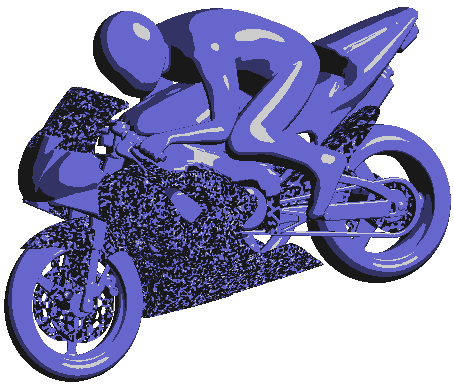
void calculate_normals() { int i; for(i = 0; i < vertices*3; ++i) normal[i] = 0.0; for(i = 0; i < faces; ++i) { int p1 = face[i*3]*3; int p2 = face[i*3+1]*3; int p3 = face[i*3+2]*3; float ux = vertex[p3]-vertex[p1]; float uy = vertex[p3+1]-vertex[p1+1]; float uz = vertex[p3+2]-vertex[p1+2]; float vx = vertex[p2]-vertex[p1]; float vy = vertex[p2+1]-vertex[p1+1]; float vz = vertex[p2+2]-vertex[p1+2]; float nx = uy*vz - uz*vy; float ny = uz*vx - ux*vz; float nz = ux*vy - uy*vx; float length = sqrt(nx*nx+ny*ny+nz*nz); normal[p1] += nx/length; normal[p1+1] += ny/length; normal[p1+2] += nz/length; normal[p2] += nx/length; normal[p2+1] += ny/length; normal[p2+2] += nz/length; normal[p3] += nx/length; normal[p3+1] += ny/length; normal[p3+2] += nz/length; } }
called in
main()right afterread_wavefront("motorBike.obj");. Now mistery occurs with garbled part of motorbike. Where the problem is? Possible suggestions: pointer problems, memory leackage, normals calculation, OpenGL bug, shader, data, ... Use debugger, Valgrind and VisIt (normals) to locate the problem. Hint: Observe number of triangles versus number of vertices. Quick fix is given as final motorbike.c source.
Homework
- Colorize the model by groups
- Add opacity (alpha)
- Find (or create) nice shader source
- Add scientific data such as pressure at the surface
- Draw streamlines with velocity colorization
- Convert example into GPU buffered (VBOs).
- Combine sliced pressure data(VTK) and model (OBJ) together as custom CFD visualization not available in visualization tools to date.
Attachments (24)
-
ex1-5.png (6.0 KB) - added by 12 years ago.
Exercise #1.5
-
first.png (3.9 KB) - added by 12 years ago.
Legacy sample
-
triangle.png (2.9 KB) - added by 12 years ago.
First GLSL example
-
OpenGL-pipeline.svg (19.7 KB) - added by 12 years ago.
OpenL pipeline
-
temperature.png (5.8 KB) - added by 12 years ago.
Temperature varying field
-
teapot.png (6.2 KB) - added by 12 years ago.
Famous Utah teapot from GLUT
-
trackball.h (3.2 KB) - added by 12 years ago.
Header for trackball
-
trackball.c (8.9 KB) - added by 12 years ago.
Virtual trackball source for interactivity
-
motorBike.obj.gz (3.6 MB) - added by 12 years ago.
Example mesh from OpenFOAM tutorials/incompressible/simpleFoam/motorBike/constant/triSurface
-
motorBike-subset.png (66.4 KB) - added by 12 years ago.
Complete motorBike mesh in VisIt
-
motorBike.obj (10.2 MB) - added by 12 years ago.
Example mesh from OpenFOAM tutorials/incompressible/simpleFoam/motorBike/constant/triSurface
-
motorBike.stl.bz2 (9.4 MB) - added by 12 years ago.
STL example from 1.7.1/run/tutorials/incompressible/simpleFoam/motorBike/constant/triSurface
-
copper-mix.png (30.7 KB) - added by 12 years ago.
Copper mix Gouraud shading of the Teapot
-
point-cloud.png (26.7 KB) - added by 12 years ago.
Point cloud from single vertex array
-
helmet.obj (303.4 KB) - added by 12 years ago.
Rider's helmet with center at (0.5, 0, 1.2)
-
temperature.c (5.2 KB) - added by 12 years ago.
Exercise 2.2
-
teapot.c (4.7 KB) - added by 12 years ago.
Extended teapot example
-
wavefront.c (1.9 KB) - added by 12 years ago.
Wavefront converter
-
motorbike-shadow.png (28.2 KB) - added by 12 years ago.
Garbled normals on some parts of motorbike
-
motorbike-final.png (13.1 KB) - added by 12 years ago.
Tooned motorbike example
-
motorbike.c (8.0 KB) - added by 12 years ago.
Final motorbike source
-
p_yNormal.vtk (1.7 MB) - added by 12 years ago.
motorBike VTK data for pressure at cutting plane at time 500
-
pressure.png (22.3 KB) - added by 12 years ago.
Pressure from p_yNormal.vtk
-
pressure.c (6.7 KB) - added by 12 years ago.
Pressure example


